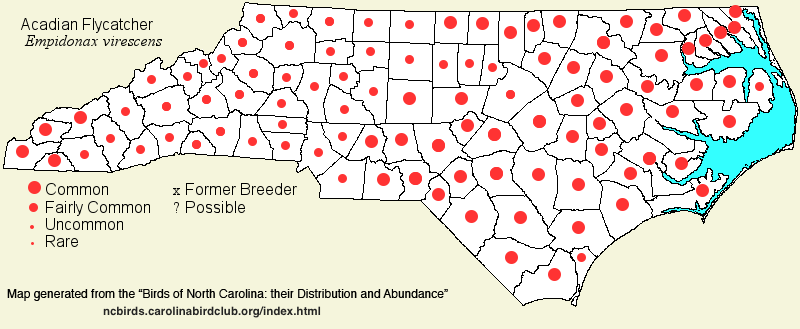 |  |
|
Acadian Flycatcher - Empidonax virescens TYRANNIDAE Members: | Search Common: Search Scientific: |
|
|
|||||||
| General Comments | The Acadian Flycatcher breeds over most of the eastern United States, being one of the characteristic birds of the Eastern deciduous forest, though occurring mainly near creeks and in floodplains. In the state, it is the only one of the Empidonax flycatchers that nests away from the mountains (except for the Willow Flycatcher in a few Piedmont locations); in fact, it nests in all 100 counties. Unlike a number of other Eastern forest birds, numbers of Acadians seem to be holding reasonably steady, not showing obvious declines. It is found primarily in moist hardwood forests (always avoiding pines), usually near a creek or in bottomland forests, less so in deep swamps. However, it is not a canopy bird, but it forages in the understory, usually about 20-50' above ground. Nests are often built on down-hanging branches directly over a creek. | ||||||
| Breeding Status | Breeder | ||||||
| NC BRC List | Definitive | ||||||
| State Status | |||||||
| U.S. Status | |||||||
| State Rank | S5B | ||||||
| Global Rank | G5 | ||||||
| Coastal Plain | Summer resident. Fairly common to common over nearly all of the province, though absent along many or most coastal islands, even where hardwood forests are present. Most numerous in floodplains such as along the Roanoke River. Mainly late Apr to late Sep; departure dates are hard to define, as birds are often silent in fall, and they can be easily confused with other Empidonax species. No records from Nov to mid-Apr. Peak counts: | ||||||
| Piedmont | Summer resident. Fairly common to common over the province. Arrives in late Apr, but departure dates unclear, though likely in Sep, to rarely early Oct. One photographed along Howerton Road (Guilford) on 4 Nov 2020 might be our latest date. Peak counts: | ||||||
| Mountains | Summer resident. Fairly common to common at lower elevations (below 3,500 feet), but uncommon to about 4,000 feet. Does not breed at higher elevations. Mainly late Apr into fall, perhaps to early Oct. Peak counts: | ||||||
| Finding Tips |
This species is heard from many bridges that cross forested creeks across the state. Walking along a road that bisects a floodplain usually reveals the species back into the forest. Birds can be somewhat difficult to spot, and even though they perch on exposed twigs (looking for prey) in the understory, they move very little and often do not come in to tapes that are played. *** to **** | ||||||
| Attribution | LeGrand[2023-03-24], LeGrand[2021-03-06], LeGrand[2012-07-15] | ||||||
| NC Map Map depicts all counties with a report (transient or resident) for the species. | Click on county for list of all known species. |
| NC Breeding Season Map Map depicts assumed breeding season abundance for the species. |  |